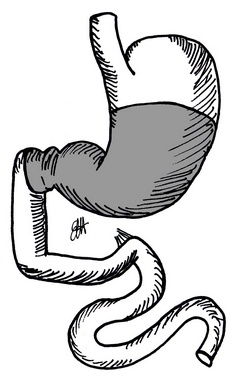|
The Billroth II procedure is a variation to the Billroth I procedure pioneered by Dr. Theodor Billroth in 1881. The procedure is a a "subtotal gastrectomy" where gastrointestinal continuity after the resection is attained with an anastomosis between the stomach and the jejunum, a gastrojejunostomy. The procedure was originally performed as a way to resect peptic ulcers caused by hyperacidity. Billroth removed up to 70% of the stomach. Modern variations of the procedure are less agressive, resecting only 50% of the distal stomach (a hemigastrectomy), or an antrectomy. The reason for the Billroth II variation is the difficulty performing a gastroduodenostomy. This can be caused by a short abdominal esophagus, a short proximal gastric pouch or other reasons. The accompanying image shows the digestive tract before the resection. The area to the resected (specimen) is grayed out. If you hover your cursor over the image you will see the completed Billroth II procedure. In the completed procedure you can see A: The stapled-closed duodenal stump. B: The gastrojejunostomy that allows passage of food from the stomach into the jejunum, and C: the staple-closed gastric stump that is not part of the gastrojejunostomy. Bear in mind that this sketch depicts only one of the many ways of performing this procedure Image property of: CAA.Inc. Artist: Dr. E. Miranda |
 |
| MTD Main Page | Subscribe to MTD |